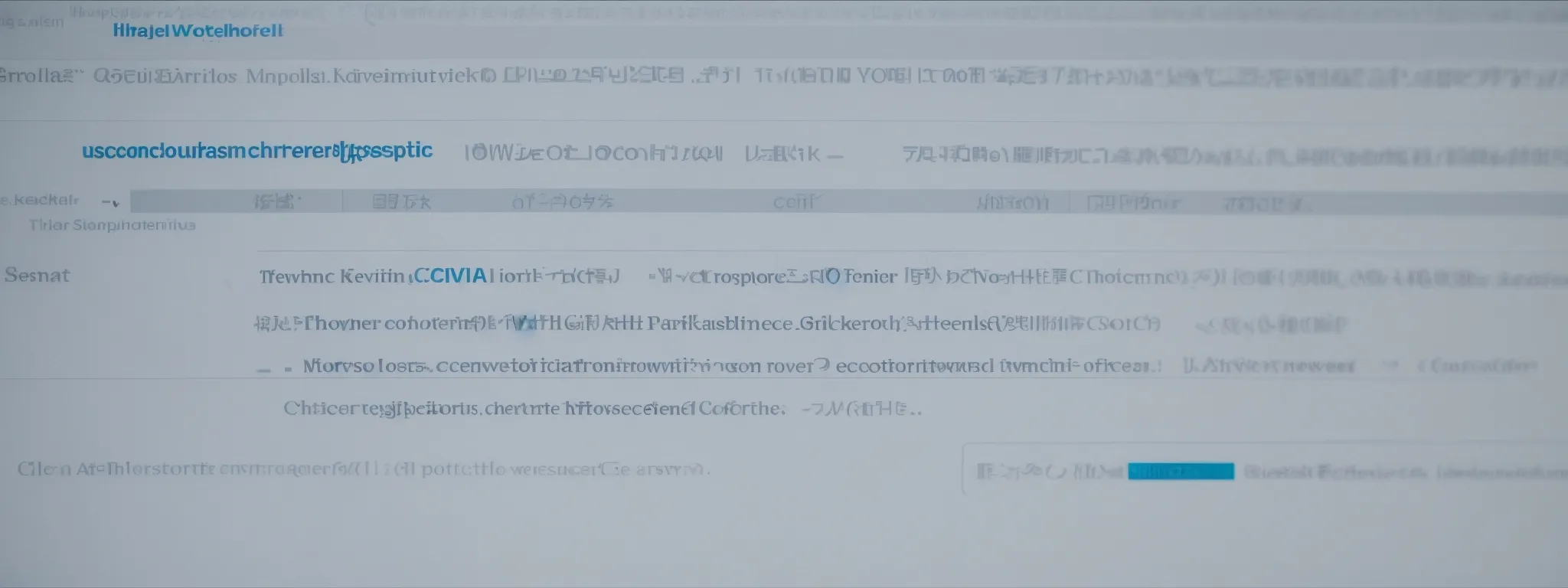Make the Right Landing Page Rank SEO Checklist
Ultimate SEO Checklist for Landing Page Optimization Landing pages serve as the pivotal touchpoints within the digital marketing ecosystem, directly influencing conversion rates and reflecting a brand’s […]
Ultimate SEO Checklist for Landing Page Optimization
Landing pages serve as the pivotal touchpoints within the digital marketing ecosystem, directly influencing conversion rates and reflecting a brand’s commitment to user experience.
With LinkGraph’s SEO services, optimizing these key pages transcends the basics; it involves a meticulous blend of technical finesse and creative articulation.
The Ultimate SEO Checklist transforms landing pages into compelling narratives that not only resonate with target audiences but also satisfy the rigorous demands of search engine algorithms.
Keep reading to unlock the full potential of your landing pages through strategic SEO enhancements that promise to elevate your brand’s digital footprint.
Key Takeaways
- Title Tags Should Be Strategically Crafted With Keyword Placement and Brand Inclusion to Enhance SEO
- Meta Descriptions Require Precise Language and a Compelling Call to Action to Boost Click-Through Rates
- Header Tags Must Integrate Target Keywords and Enhance Readability for Successful on-Page SEO
- Internal Linking With Descriptive Anchor Text Improves Navigation and SEO, Balancing No-Follow and Do-Follow Links
- Mobile Responsiveness With Optimized Loading Speeds and Intuitive Navigation Is Crucial for Landing Page SEO Success
Crafting Engaging Title Tags for SEO Impact

In an era where every click is an opportunity for conversion, the art of refining SEO elements on landing pages is non-negotiable.
Among these critical elements, the title tag stands as a beacon guiding search engines and searchers alike towards relevant content.
A meticulously crafted title tag not only champions your main keyword, but also adheres to character limitations to prevent truncation in search engine results pages (SERPs).
Furthermore, when branding is woven subtly into the end of a title tag, it adds a layer of recognition while ensuring uniqueness.
This care in composition is integral to preventing the common pitfall of duplicate title tags, which can dilute a page’s SEO efficacy.
As we delve into the linchpin of landing page SEO, let’s explore best practices for constructing title tags that marry brevity with strategy, truly capturing the essence of the page content.
Ensure Your Main Keyword Is in the Title Tag
Integrating the target keyword seamlessly into a title tag is a keystone strategy of on-page SEO services. It enables a landing page to assert its relevance to the search query, bolstering its potential to rank prominently on Google search results.
To optimize for both user experience and SEO ranking factors, a title tag must incorporate the target keyword in a natural, compelling manner. This practice ensures that the essence of the landing page is communicated succinctly to both the search engine and the potential visitor scanning the search results.
Keep the Title Tag Under 60 Characters
Brevity is the soul of wit, and nowhere is this truer than in the world of SEO. A title tag that exceeds 60 characters risks being truncated in SERPs, obscuring the full message intended for the audience: a detrimental impact for any campaign aiming to maximize click-through rates (CTRs).
When constructing a title tag, it’s vital to consider the constraint of 60 characters as a creative challenge. Adhering to this limit compels the SEO copywriter to distill the essence of a landing page into a crisp, potent invitation to potential visitors:
| SEO factor | Best Practice |
|---|---|
| Title Tag Length | Stay under 60 characters to avoid truncation |
| Keyword Placement | Include the target keyword towards the beginning |
| Brand Inclusion | Incorporate brand name succinctly at the end |
Incorporate Branding Towards the End
Strategically incorporating a brand’s name towards the end of a title tag serves dual purposes: enhancing brand recall and elevating domain authority. It’s a subtle nod asserting the source’s credibility, prompting user recognition when sifting through a sea of search results.
This placement of branding should not overshadow the main message but rather complement it, ensuring the page title remains primarily focused on the user’s search intent. The finality of a well-placed brand name can leave a lasting impression, anchoring the essence of the landing page in the minds of prospective visitors:
| Title Tag Component | Recommendation |
|---|---|
| Target Keyword | Feature prominently at the start of the tag |
| Message Clarity | Ensure main intent is communicated succinctly |
| Branding | Incorporate at the end to reinforce recognition |
Avoid Duplicate Title Tags Across Pages
In the quest for achieving peak SEO performance, vigilance against duplicate title tags becomes a paramount concern. Unique title tags are not merely a recommendation but a necessity for distinguishing each landing page in the vast expanse of the digital landscape.
Search engines, striving to deliver the most relevant content, are confounded by repetitive title tags, potentially dispersing the SEO value and diminishing the distinct identity of pages. Singular, well-formulated title tags anchor each page’s uniqueness, bolstering its integrity in the search engine’s eyes:
- Maintain distinctive title tags to enhance the individuality of each page.
- Utilize creative variations to sidestep the pitfalls of repetition while preserving search intent.
- Monitor title tags regularly as part of a comprehensive site audit to ensure continued uniqueness and relevancy.
Writing Meta Descriptions That Encourage Click-Throughs

The persuasive power of meta descriptions lies in their capacity to elevate click-through rates, serving as a deciding factor for users contemplating whether to visit a landing page.
As a succinct showcase of what searchers can expect upon arrival, meta descriptions demand precise language that not only resonates with the intended audience but also encapsulates the page’s value proposition.
Crafting these snippets with clarity involves tactful keyword integration, vivid summaries that capture user interest, and compelling calls to action that guide users towards the next step.
In the realm of search engine optimization, these brief yet impactful elements are instrumental in enhancing visibility and driving user engagement.
Insert Target Keywords Naturally
Effectively incorporating target keywords into meta descriptions is paramount for aligning with searchers’ intent and enhancing the visibility of a web page. This strategy gestures to search engines the relevance of the content, thus potentially driving higher rankings and more focused traffic to the landing page.
LinkGraph’s SEO services specialize in integrating keywords with a natural finesse, ensuring meta descriptions provide a seamless reading experience. By infusing target keywords authentically, they foster a stronger connection between the landing page content and the audience’s expectations.
Summarize the Page Content Compellingly
In crafting meta descriptions that grip potential visitors, distilling the core message of a landing page into a succinct summary is essential. By conveying the unique selling points and value succinctly, these descriptions can intrigue and motivate searchers to click through, promising them content that satisfies their search needs.
LinkGraph’s SEO experts excel in pinpointing a landing page’s essence and translating that into compelling meta descriptions. A strong emphasis on the active voice and persuasive language ensures that each meta description acts as an invitation, compelling searchers to explore the depth of the landing page’s content.
Use Action-Oriented Language
Meta descriptions serve as a decisive factor in a user’s journey, propelling them from the search engine results pages to the landing page. Crafting these carefully is a hallmark of LinkGraph’s SEO content strategy, where active language ignites the searcher’s interest and encourages the pivotal click.
The inclusion of dynamic verbs and a direct call to action transforms the meta description from a mere summary to an irresistible invitation. LinkGraph’s expertise ensures that every snippet, with its clear directive and energetic language, resonates with the readers, catalyzing their transition from visitors to potential customers.
Optimizing Header Tags for Clarity and Keyword Use

Ensuring the clarity and effectiveness of header tags is a cornerstone of on-page SEO services, fundamental for any successful landing page optimization.
Header tags, particularly H1s, are pivotal in signifying the central theme to search engines and users alike.
By incorporating target keywords judiciously within these tags, a landing page can articulate its relevance and content hierarchy.
The strategic use of H2s and H3s to break up content not only enhances readability but also serves as a subtle, yet powerful, lever for SEO.
LinkGraph’s SEO services emphasize the meticulous crafting of header tags to improve user experience and cement the content’s authority, contributing positively to SEO ranking factors.
Include Target Keywords in H1 Tags
The strategic placement of target keywords within H1 tags is a critical component of SEO that signals the main focus of a landing page to search engines. LinkGraph’s on-page SEO services deftly incorporate these keywords into H1 tags, ensuring they accurately reflect the page content and resonate with the user’s search query.
LinkGraph’s meticulous approach to SEO underscores the significance of H1 tags as primary indicators of a page’s topic for both search engines and users, thereby optimizing the potential for superior rankings in search results. These header tags are crafted to not only fulfill SEO best practices but also to enhance the user’s navigational experience.
Break Up Content With Subheadings (H2s, H3s)
Employing H2 and H3 subheadings elevates the structure of landing page content, guiding users through a logical progression of ideas. LinkGraph’s SEO services strategically utilize these subheadings to punctuate text, making it digestible for readers whilst signaling key sections to search engines, a technique that refines user experience and bolsters SEO efficacy.
Subheadings act as signposts within the content, providing a preview of the following section’s focus. This segmentation by LinkGraph’s professionals not only aids in maintaining user engagement with clear, manageable content blocks but also allows precise insertion of LSI keywords to augment the SEO landscape of the landing page.
Refining Content to Align With Search Intent

Landing page optimization is an intricate dance of detailing and strategy, with the audience’s search intent leading every step.
Successful alignment between page content and the user’s needs dictates the choreography of an SEO-enhanced landing page.
To raise the curtains on this synchronized performance, professionals embark on robust keyword research to uncover the topics most resonant with their target audience.
They weave Latent Semantic Indexing (LSI) keywords into the narrative, enrich finer points with FAQs targeting long-tail keywords, organize details into bullet points for scan-friendly reading, and persistently renew content to safeguard its relevance.
Each element is a thread in the fabric of a landing page, designed to captivate and convert with an eloquent display of user-oriented content and SEO sophistication.
Perform Keyword Research for Content Topics
Embarking on the journey of keyword research is a foundational step that LinkGraph’s SEO professionals regard as essential for content topic selection. It involves a nuanced approach to finding keyword ideas that fully encapsulate the searcher’s intent and align closely with the subject matter of the landing page.
LinkGraph harnesses the potency of the SearchAtlas SEO software, facilitating comprehensive research that pinpoints the precise terms and phrases an audience is seeking. This data-driven strategy informs the creation of content that not only meets the user’s informational needs but also enhances visibility within search engine results:
| Keyword Research Process | User Intent Match | SEO Outcome |
|---|---|---|
| Analyzing search volume and trends | Ensuring relevance to the search query | Improved positioning in SERPs |
| Identifying long-tail keyword opportunities | Addressing specific user queries | Targeted traffic to landing pages |
| Utilizing competitor keyword insights | Benchmarking against market standards | Strategic edge in content differentiation |
Include LSI Keywords Throughout the Text
Incorporating Latent Semantic Indexing (LSI) keywords into landing page content is a sophisticated strategy employed by LinkGraph’s SEO experts to reinforce topic relevance and context. This methodology enables a nuanced matching of page content with user queries, enriching the content’s thematic strength and comprehensiveness for search engines and users alike.
LinkGraph’s SEO services harness the power of LSI keywords to bolster on-page SEO, crafting text that resonates with search engines’ understanding of user intent. Such strategic inclusions serve to elevate the semantic richness of the landing page, cultivating an environment that’s favored by algorithms for its depth and relevance to the subject matter.
Feature FAQs to Target Long-Tail Keywords
Integrating a Frequently Asked Questions (FAQ) section on a landing page is a strategic move by LinkGraph’s SEO services that targets the utilization of long-tail keywords. Such keywords, known for their specificity, cater to more defined user inquiries, raising the potential for higher conversion rates by addressing the exact needs of a more targeted audience.
The inclusion of FAQs, when expertly implemented by LinkGraph’s SEO specialists, serves as more than an informational resource; it’s a calculated method to enhance the page’s visibility in search results. Through the anticipation of nuanced queries, FAQs crafted with long-tail keywords become an SEO asset that effectively bridges the gap between user intent and content relevance.
Use Bullet Points for Easy Skimming
Streamlining information with bullet points is more than just a visual aid; it’s a strategic element in landing page design that enhances user experience. This layout allows users to quickly grasp the key details of a product or service, promoting effortless consumption of information and retention of the main points:
- Clarity and conciseness drive the bullet point’s effectiveness in boosting user comprehension.
- Strategic placement can draw the user’s eye to benefits, features, or important data points.
- Enhanced skimmability contributes to reduced bounce rates and increased engagement.
Employing bullet points effectively aids in maintaining user focus and directing attention to the vital aspects of the page content. By breaking down complex information into bite-sized pieces, visitors are more likely to absorb the selling points and take the desired action, be it a sign-up, download, or purchase.
Update Content Regularly to Stay Relevant
To ensure the enduring success of a landing page, it is vital for content to stay abreast of industry trends and shifts in user behavior. LinkGraph recognizes that content which is frequently updated reflects the dynamic nature of the digital space, responding promptly to new information, emerging trends, and algorithm updates.
Regular revisions maintain a landing page’s competitive edge in search engine rankings and preserve its appeal to the target audience. Such diligence signals to search engines that the site is actively managed, fostering improved rankings and visitor engagement:
- Meticulously analyze user engagement data to identify areas for content enhancement.
- Schedule consistent content reviews as part of a comprehensive SEO strategy.
- Implement updates that align with the evolving needs and interests of the audience.
Streamlining Internal Link Structure for SEO

An internal link structure operates as the skeletal framework supporting a website’s navigational flow and SEO health.
The strategic implementation of links to high-priority pages ensures smooth user navigation while reinforcing the site’s architecture, both serving user needs and satisfying search engine algorithms.
Properly applied descriptive anchor text grants clarity to the linked content, enhancing both relevance and accessibility.
Balancing no-follow and do-follow links is equally important to preserve the equity of the site and sculpt the flow of page rank across the domain.
Mastery of internal linking not only garners SEO benefits but also fortifies the user’s journey from discovery to conversion on a landing page.
Add Links to High-Priority Pages
Integrating internal links to high-priority pages is a strategic move deemed essential by LinkGraph’s SEO services. It not only facilitates a seamless navigation experience for users but also guides search engine crawlers to understand which pages hold the most value, prioritizing them accordingly in search rankings.
LinkGraph’s proficiency extends to selecting the most opportune internal links, thereby enhancing the landing page’s authority and relevance within the website’s hierarchy. This deliberate emphasis on high-priority pages effectively directs traffic to the most impactful content, amplifying both user engagement and potential conversion rates.
Use Descriptive Anchor Text
Utilizing descriptive anchor text in internal linking practices is a nuanced facet of SEO that facilitates a deeper understanding for both users and search engines. Precise, keyword-rich anchor text delineates the content of the target page, bolstering the relevancy signals that search engines factor into their ranking algorithms.
LinkGraph’s strategic approach to SEO emphasizes the use of descriptive anchor text to enhance the user experience, guiding them with clarity and precision to the information they seek on high-priority pages. Decisively chosen words in the anchor text communicate the value of the linked page, elevating its status and supporting the site’s overall SEO framework:
- Anchor text should be relevant to the linked page’s content, avoiding generic terms like “click here” or “read more.”
- Integrating target keywords within the anchor text enhances context for search engine crawlers.
- Varying anchor text across the site prevents over-optimization and potential search engine penalties.
Balance No-Follow and Do-Follow Links
In the sophisticated tapestry of SEO, striking a balance between no-follow and do-follow links is crucial for sculpting a site’s link profile. LinkGraph’s SEO services adeptly manage this equilibrium, optimizing the flow of page authority throughout a client’s site and ensuring search engines can discern the site’s key pages.
This strategic approach retains link equity where most beneficial and prevents dilution of page authority across less critical content. Through LinkGraph’s expertise, clients witness a harmonious link structure that supports robust SEO rankings and fosters a user-friendly navigation experience on every landing page.
Enhancing Page Load Speed for Better Rankings

In the realm of landing page optimization, site speed emerges as a paramount SEO ranking factor that demands meticulous attention.
A swift-loading page not only delights users but also signals to search engines the commitment of a company to superior user experience, bolstering the page’s standings in search results.
LinkGraph’s emphasis on enhancing page performance encompasses a range of techniques, from image compression to streamlined server requests.
The objective is clear: to equip landing pages with the agility necessary to satisfy both the impatience of users and the stringent requirements of search algorithms.
Engaging such strategies as leveraging browser caching, deploying content delivery networks, and optimizing file sizes, sets the stage for a seamless visitor experience, prompt information access, and ultimately, a higher likelihood of conversion.
Compress Images Before Uploading
LinkGraph’s SEO services acknowledge the profound impact of image compression on page load speed, a critical SEO ranking factor. Optimizing images to reduce file size without sacrificing quality ensures that landing pages load swiftly, a vital component in retaining user engagement and improving search engine rankings.
By deftly compressing images prior to uploading, professionals at LinkGraph ensure landing pages remain visually appealing while boasting reduced load times. This practice not only enhances user experience but also serves as a testament to a company’s dedication to performance optimization, a key determinant in securing competitive advantages in Google search results.
Minimize HTTP Requests
Within the sphere of SEO, minimizing HTTP requests stands as an imperative tactic for elevating page load speed. LinkGraph’s SEO services target this performance enhancement by consolidating files, utilizing CSS sprites, and streamlining scripts, ensuring that each landing page operates at its peak efficiency for superior ranking prospects.
This minimization strategy not only optimizes response time for end users but also signifies to search engines a site’s robust technical health. By limiting the number of server requests during page loading, LinkGraph aids clients in crafting expedient digital experiences that keep user attention focused on content rather than buffering indicators.
Leverage Browser Caching
Leveraging browser caching emerges as a pivotal tactic in optimizing landing page performance, an initiative diligently pursued by LinkGraph’s SEO services. The technique involves storing elements of web pages locally in the visitor’s browser, reducing the number of server requests during subsequent visits and thus, markedly accelerating page load times.
This aspect of technical SEO underpins the user experience by allowing repeat visitors to access content with notable swiftness. LinkGraph’s strategic implementation of caching policies signals to search engines the proficiency of a landing page’s load efficiency, a factor that can significantly improve search rankings and user satisfaction.
Implement Content Delivery Networks
In a world where milliseconds can dictate the success of a user’s website experience, LinkGraph leverages the prowess of Content Delivery Networks (CDNs) to expedite content distribution across the globe. By caching website content on multiple, geographically dispersed servers, CDNs enable faster access to landing pages, regardless of the user’s location, significantly reducing load times.
CDNs stand at the forefront of SEO as they not only impact user experience but also play a crucial role in search engine evaluation of site speed—one of the myriad factors informing search rankings. LinkGraph ensures that through the strategic use of CDNs, clients’ landing pages are positioned for prompt delivery, thus enhancing both the perception of speed and the actual performance metrics that contribute to SEO strength.
Boosting Mobile Responsiveness for User Experience

As the digital landscape tilts increasingly towards mobile-first indexing, optimizing for mobile responsiveness has become an indispensable element of any landing page SEO strategy.
Recognizing this shift, businesses must adapt to the evolving habits of users predominately accessing the web via mobile devices.
An SEO checklist for impactful landing page optimization now mandates responsive web design, which ensures an optimal viewing experience across an array of devices.
It’s not simply about resizing content to fit screens, but creating an environment where touchscreen readability and fluid navigation coalesce, and pages load expeditiously.
With AMP (Accelerated Mobile Pages) becoming more prevalent, the importance of quick-loading mobile pages cannot be overstated in the quest to improve user experience and search engine rankings.
Use Responsive Web Design Practices
Embracing the principles of responsive web design, LinkGraph crafts landing pages that fluidly adapt to any device or screen size, ensuring that every user enjoys an optimal viewing experience. This approach accounts for the multitude of devices from which users might access content, prioritizing adaptability and user-centric design across the digital landscape.
Recognizing the significance of mobile responsiveness as a critical SEO ranking factor, LinkGraph’s SEO services meticulously implement designs that facilitate seamless navigation and readability on mobile platforms. Such diligence ensures landing pages retain functionality and appeal, irrespective of the user’s choice of technology, thus enhancing both user satisfaction and SEO outcomes.
Prioritize Touchscreen Readability and Navigation
In the realm of mobile optimization, prioritizing touchscreen readability and navigation is an exercise in foresight and user empathy. LinkGraph understands that a landing page must facilitate effortless interaction, with text and links easily tapped, and interfaces scaled for finger-based navigation.
Ensuring that call-to-action buttons and interactive elements are adequately sized and responsively placed eliminates user frustration and supports conversion optimization objectives. Pages optimized for touch encourage longer engagements and a smoother journey through to the desired action:
| Design Element | Consideration | Impact on User Experience |
|---|---|---|
| Text Size and Spacing | Legible font sizes with touch-friendly spacing | Enhanced readability and reduce misclicks |
| CTA Button Size | Large, easily tappable areas | Increased interaction and conversion rates |
| Navigation Menus | Simplified and intuitive layout | Faster, smoother site exploration |
LinkGraph’s dedicated approach to mobile experiences extends to precise adjustments that consider the nuances of touchscreen usability. It’s not merely about visual appeal but about crafting an interactive landscape where touch governs and guides the user towards a seamless viewing experience.
Accelerate Mobile Pages With AMP
In the pursuit of delivering top-tier mobile experiences, LinkGraph advocates for the integration of Accelerated Mobile Pages (AMP). This initiative is a collaborative effort designed to streamline the creation of mobile content that loads instantaneously, thus minimizing wait times for users and enhancing overall engagement.
AMP contributes significantly to a landing page’s mobile-friendliness, a factor that plays a pivotal role in Google’s ranking algorithm. By adopting AMP, businesses signal to search engines and users their commitment to providing a fast, responsive mobile web experience:
- AMP implementation prioritizes user experience by vastly improving page load speed on mobile devices.
- It enhances the likelihood of higher visibility in search results, potentially leading to increased traffic and conversion rates.
Conclusion
The “Ultimate SEO Checklist for Landing Page Optimization” is crucial for enhancing online visibility and user engagement.
Prioritizing key elements such as crafting concise title tags with targeted keywords, writing compelling meta descriptions, and optimizing header tags improves clarity and search engine ranking potential.
Content must align with search intent by employing thorough keyword research and updating regularly to stay relevant.
An efficient internal link structure amplifies the usability and SEO strength of landing pages.
Meanwhile, optimizing page load speed ensures swift user experiences, a critical factor for retention and conversion.
Finally, boosting mobile responsiveness with practices such as responsive web design and AMP implementation caters to the growing majority of mobile users, reinforcing the page’s appeal and performance.
Collectively, these strategies form an indispensable blueprint for building landing pages that not only rank well but also captivate and convert visitors effectively.















































































